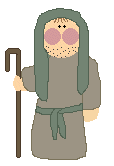
This is me in 2012 at the Hard Rock Cafe in Chicago, Illinois.

I know it's hard to see me, but here I am with Jimi Hendrix guitar at the hard Rock Cafe in Chicago!

~The 23rd Psalm of David~
"The LORD is my shepherd; I shall not want.
He maketh me to lie down in green pastures:
he leadeth me beside the still waters.
He restoreth my soul:
he leadeth me in the paths of righteousness for his name's sake.
Yea, though I walk through the valley of the shadow of death,
I will fear no evil: for thou art with me; thy rod and thy staff they comfort me.
Thou preparest a table before me in the presence of mine enemies:
thou anointest my head with oil; my cup runneth over.
Surely goodness and mercy shall follow me all the days of my life:
and I will dwell in the house of the LORD for ever."
As early as 10,000 years ago, in Central Asia, man had discovered that the animal "sheep" could provide him with both covering and food. At first, man used the sheep's fleece as a kind of a tunic. Then, around 3,500 B.C., man discovered how to spin wool. Fragments of knitted fabric have been found in Egyptian tombs dating back to the 5th Century B.C.
In the Middle Ages, European farmers discovered that sheep were the most productive of all livestock. In addition to producing meat, wool, and skins for making parchment paper, sheep were milked. It was estimated that 20 ewes would provide enough milk to make 5 pints of butter and 250 pounds of cheese. By the 14th Century, whole herds of sheep were being milked in England.
In America, the first sheep were originally from Spain and were introduced into southwestern United States in 1519 by Spanish troops under Cortez. It is thought that the flocks of sheep belonging to the Native American Navajos are descended from multi-colored sheep brought to North America by the Spanish.
Fifteen years after the Pilgrims landed at Plymouth Rock, they purchased 40 sheep from the Dutch colonists on Manhattan Island. The first British sheep were brought to Virginia in 1609 by the London Company. Gradually, with sheep smuggled into the new country, the flocks were large enough that the colonists were able to ship wool to other countries in exchange for trade goods. This enraged the English government and the punishment for trading sheep or wool was to have the offender's right hand cut off.
Along with the passage of the Stamp Act, resentment over British restrictions on the sheep and wool industry led to the Revolutionary War. Spinning and weaving were considered patriotic acts. Home knitting was also encouraged as those who produced knitted cloth received 6 pounds of tobacco for each yard of cloth they produced.
George Washington raised sheep on his Mount Vernon estate. Both George Washington and Thomas Jefferson wore suits made from American wool to their presidential inaugurations.
In the early 1800's, the United States imported Merino sheep from Spain. In the middle of the 19th century, pioneers seeking new lands in western and northwestern United States brought sheep with them. Eventually, the sheep from eastern herds were mixed with the Spanish sheep in the southwest.
Today, about 85% of all breeding sheep in the United States are west of the Mississippi River, mainly in the western range states.





Kaleb with Speckledore, one of his brockle-face twins, from his 2011 Grand Champion Dorset breeding ewe.
Speckledore has a long dock because he was not going to be utilized for show and a longer tail dock is healthier for a sheep that is going to have a
long life.
GANGSTER




